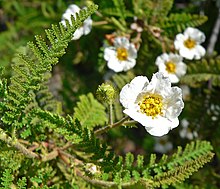Chamaebatia
Appearance
| Chamaebatia | |
|---|---|

| |
| Chamaebatia australis | |
| Scientific classification | |
| Kingdom: | |
| (unranked): | |
| (unranked): | |
| (unranked): | |
| Order: | |
| Family: | |
| Subfamily: | |
| Genus: | Chamaebatia |
| Species | |
Chamaebatia, also known as mountain misery, is a genus of two species of aromatic evergreen shrubs endemic to California. Its English common name derives from early settlers' experience with the plant's dense tangle and sticky, strong-smelling resin.[2][3] They are actinorhizal, non-legumes capable of nitrogen fixation through symbiosis with actinobacteria Frankia.[4][5]
Species
- Chamaebatia australis - Southern mountain misery
- Chamaebatia foliolosa - Sierra mountain misery, bearclover, kit-kit-dizze[2]
References
- ^ Potter, D.; et al. (2007). "Phylogeny and classification of Rosaceae". Plant Systematics and Evolution. 266 (1–2): 5–43. doi:10.1007/s00606-007-0539-9.
{{cite journal}}: Explicit use of et al. in:|last2=(help) - ^ a b Karen Wiese (5 February 2013). Sierra Nevada Wildflowers, 2nd: A Field Guide to Common Wildflowers and Shrubs of the Sierra Nevada. FalconGuides. p. 188. ISBN 978-0-7627-8034-1.
- ^ Bibby, Brian; Aguilar, Dugan (2005). Deeper Than Gold: Indian Life in the Sierra Foothills. Heyday. p. 101. ISBN 978-0-930588-96-0.
- ^ Swensen, S.M.; Mullin, B.C. (1997). "The impact of molecular systematics on hypotheses for the evolution of root nodule symbioses and implications for expanding symbioses to new host plant genera". Plant and Soil. 194: 185–192. doi:10.1023/A:1004240004063.
- ^ Oakley, B.; North, M.; Franklin, J. F.; Hedlund, B. P.; Staley, J. T. (2004). "Diversity and Distribution of Frankia Strains Symbiotic with Ceanothus in California". Applied and Environmental Microbiology. 70 (11): 6444–6452. doi:10.1128/AEM.70.11.6444-6452.2004. ISSN 0099-2240. PMC 525117. PMID 15528504.
Frankia strains symbiotic with Chamaebatia (Rosaceae) were within the same clade as several Ceanothus symbionts
